What is the link between a land and a name?
In 2006 on a tour of the Scottish Borders, as I visited the Liddesdale and Eskdale river valleys, I came to appreciate my Scottish roots and the connection between my clan name and the land of my ancestors. In a Langholm pub hung my coat of arms with the image of a flexed, muscular arm. Outside the Castleton graveyard I saw one of the oldest Armstrong relics, the Milnholm Cross from 1300, erected to honor Alexander Armstrong, a clan laird, or chief, murdered at Hermitage Castle. That cross also had the clan image. In the graveyard were hundreds of Armstrong gravestones, some almost illegible, dating back hundreds of years. All around me were signs of my distant ancestors, their immediate connection to me still unknown.
Next Tuesday at 6:30 p.m. in Pioneer Hall Room 201, Kachemak Bay Campus, in a talk, “It’s All In a Name,” Nancy Lee-Evans of the Kachemak Celtic Club explores the connections between family names of the Celtic peoples and the lands they came from.
“Your name is a doorway to your culture — a clan, their lands and history,” Lee-Evans said.
Formerly known as the Kachemak Scottish Club, the Kachemak Celtic Club has been expanded to celebrate the culture, history and heritage of Celtic cultures. “It’s All in a Name” starts a series of talks and discussions about aspects of Celtic culture. Other events include a St. Patrick’s Day celebration March 17 at Alice’s Champagne Palace, a Tartan Day event in April and the Scottish Highland Games next summer.
Lee-Evans runs the Anam Cara Program, a program of spiritual development and healing rooted in Celtic traditions. She has a doctorate in indigenous Celtic traditions from Wisdom University, California, and also runs heritage tours to Ireland and Scotland.
The Celts descended from the ancient people who sought refuge in ice-free corners of Europe during the last ice age about 10,000 years ago, Lee-Evans said. New research, in the past 30 years, particularly in genetics, has shown the spread of the Celts into France, Germany, Switzerland, northern Italy and even into Eastern Europe. Many of these Celtic traditions were suppressed during the Roman conquest.
“If you just scratch under the surface, you’ll find the Celts,” Lee-Evans said.
Modern Celtic cultures — the Atlantic Celts — survive in Ireland, Scotland, Cornwall, Wales, the Isle of Man, Brittany and Gallacia or northern Spain.
In her discussion, Lee-Evans will use maps, histories and genealogies to show where surnames came from in Ireland, Scotland and other areas.
“It’s more than the O’s and the Macs,” she said, referring to the traditional prefixes to Irish and Scottish names — O’Neill and MacDonald, for example.
The Scottish Border clans, for example, include not just the Armstrongs, but Johnston, Nixon, Elliot, Graham, Bell, Maxwell and other names.
People who may know their ancestry, but not necessarily where clan names came from, can ask questions to find possible origins. Lee-Evans will have books on clan history, discussions of coats of arms and maps — lots of maps.
“I think there will be a fair amount of talking with maps,” Lee-Evans said. “To me, the most important thing is to say ‘This is where your people are from.”
The history of surnames and their connection to lands also includes a discussion of tribal movements. Many of the Border clans, for example, emigrated to Ireland, particularly Ulster and the northern counties. Some were forced out, as during the Highland Clearances. Emigrants to Ulster became emigrants again when many of the Ulster Scots — the Scotch Irish — left later for North America and the American colonies. Irish also left later during the potato famines. Many were forced by religious or cultural persecution to leave.
“What’s your family story?”
Lee-Evans asked. “One of the things that’s clear is everybody came by
ship. … Literally, we were all in the same boat.”
That connection between name and land is only part of the story of the Celtic culture. Lee-Evans said in future talks she hopes to look deeper into Celtic culture through history and spiritual development.
Michael Armstrong can be reached at michael.armstrong@homernews.com.


